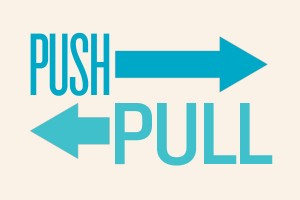 Marketing executives today need to be up to date on the newest terminologies and methods of implementation, and if you want to work in marketing, you need to understand the differences in push vs. pull marketing. While some companies still cling to the idea of word of mouth advertising and letting customers come to them, other companies know that they need to get out in the world and give customers a reason to come to them. Understanding the differences between the two methods can help you work more effectively with your clients and give them what they want.
Marketing executives today need to be up to date on the newest terminologies and methods of implementation, and if you want to work in marketing, you need to understand the differences in push vs. pull marketing. While some companies still cling to the idea of word of mouth advertising and letting customers come to them, other companies know that they need to get out in the world and give customers a reason to come to them. Understanding the differences between the two methods can help you work more effectively with your clients and give them what they want.
What is Push Marketing?
Push marketing gets its name from the fact that companies essentially “push” their products onto consumers. Instead of relying on a website or a coupon to bring in new customers, those companies find ways to get their products out into the world. You might arrange for a retail chain to place your client’s new product on an end cap or in a highly visible area of the store, or you might go to a trade show and encourage stores to stock the products available from one specific company.
What is Pull Marketing?
One of the biggest differences between push vs. pull marketing is in the way companies make sales. As an advertiser, you want to rely on some type of marketing that will encourage customers to seek out the products made by your client. Direct mail marketing is one type of pull marketing. With direct mail marketing, you target customers who are more likely to buy products based on previous purchases. For example, a diaper company might send mailers to people who bought formula and baby food. Loyalty programs and coupons are other examples of pull marketing.
Differences in Strategy
According to Henry Adaso, one key difference between push vs. pull marketing is strategy. With push marketing, advertisers find ways to get new products in the faces of customers and make those customers remember those products. Placing billboards along busy highways will force drivers to see those ads every day, and using television and radio ads will let you target those driving in their cars and those relaxing at home. Pull marketing takes a more laid back approach to selling. Instead of actively targeting customers, you find ways to make customers locate you. Many companies create blogs, websites and pages on social networking sites. They hire writers to create content and use keywords that target the words and phrases people look for on search engines. Customers who find that site might stick around to learn more about the available products.
Differences in Implementation
Another difference between the two types of marketing is in the implementation of those advertising campaigns. Push marketing focuses more on the offline world. Companies and advertisers try to entice customers through mailers and coupons that will get them off the couch and into the stores. Pull marketing often uses online methods. A local dentist might encourage patients to download a copy of his or her free e-book and invite patients to come in for a free consultation.
Related Resource: Digital Marketing
Whether you’re still in college, a recent graduate or have years of marketing experience, you still need to know about the types of marketing and advertising used today. The key differences between push vs pull marketing, including the strategy and implementation behind those methods, can help you find the best way to advertise for your next client.